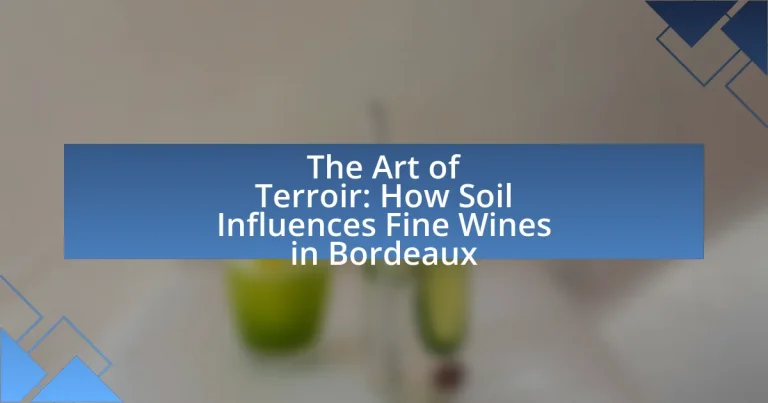Terroir is a critical concept in Bordeaux wines, encompassing the unique environmental factors such as soil, climate, and topography that shape the characteristics of the wine produced in the region. The article explores how different soil types, including gravel, clay, and limestone, influence grape varieties and ultimately affect the flavor profiles and quality of Bordeaux wines. It also examines the role of climate and geography in defining terroir, the importance of understanding terroir for wine producers, and the challenges they face in maintaining its integrity. Additionally, the article discusses sustainable practices that can enhance terroir expression and offers tips for wine enthusiasts to appreciate the distinctiveness of Bordeaux wines.

What is Terroir and Why is it Important in Bordeaux Wines?
Terroir refers to the unique combination of environmental factors, including soil, climate, and topography, that influence the characteristics of wine produced in a specific region. In Bordeaux, terroir is crucial because it determines the flavor profile, aroma, and quality of the wines. The diverse soils of Bordeaux, such as gravel, clay, and limestone, contribute to the distinctiveness of its wines, allowing for the cultivation of various grape varieties that thrive in these conditions. For instance, the gravelly soils of the Médoc region are ideal for Cabernet Sauvignon, while the clay-rich soils of Saint-Émilion favor Merlot. This relationship between terroir and grape quality is supported by the classification of Bordeaux wines, which emphasizes the importance of specific vineyard sites and their unique terroirs in determining wine excellence.
How does Terroir Influence the Characteristics of Wine?
Terroir significantly influences the characteristics of wine by encompassing the unique environmental factors of a specific vineyard site, including soil composition, climate, and topography. These elements interact to affect grape growth and development, ultimately shaping the wine’s flavor profile, aroma, and texture. For instance, in Bordeaux, the diverse soil types, such as gravel, clay, and limestone, contribute to the distinctiveness of wines produced in different regions, with gravel enhancing drainage and heat retention, which benefits varietals like Cabernet Sauvignon. Studies have shown that wines from specific terroirs exhibit unique chemical compositions, leading to variations in taste and quality, thus validating the critical role of terroir in winemaking.
What are the key components of Terroir in Bordeaux?
The key components of Terroir in Bordeaux include soil composition, climate, topography, and grape variety. Soil composition in Bordeaux is diverse, featuring gravel, clay, limestone, and sand, which influence drainage and nutrient availability for vines. The climate is characterized by a maritime influence, with moderate temperatures and rainfall patterns that affect grape ripening. Topography, including the region’s hills and valleys, impacts sunlight exposure and air circulation, further shaping the growing conditions. Lastly, the selection of grape varieties, such as Merlot, Cabernet Sauvignon, and Cabernet Franc, is tailored to the specific terroir, enhancing the unique characteristics of Bordeaux wines. These components collectively contribute to the distinctiveness of Bordeaux wines, as evidenced by the region’s classification system that recognizes the importance of terroir in wine quality.
How do climate and geography contribute to Terroir?
Climate and geography significantly shape terroir by influencing the growth conditions of grapevines. The climate determines temperature, rainfall, and sunlight, which affect grape ripening and flavor development. For instance, Bordeaux’s maritime climate provides mild winters and warm summers, ideal for cultivating grape varieties like Merlot and Cabernet Sauvignon. Geography, including soil composition and topography, further impacts drainage and nutrient availability. In Bordeaux, the diverse soils—ranging from gravel to clay—contribute to the distinct characteristics of wines produced in different regions, such as the Left Bank and Right Bank. This interplay of climate and geography creates unique terroirs that define the quality and style of Bordeaux wines.
What Role Does Soil Play in Defining Terroir?
Soil plays a crucial role in defining terroir by influencing the characteristics of the grapes grown in a specific region. The composition, drainage, and mineral content of the soil affect vine health, grape ripeness, and flavor profiles. For instance, Bordeaux’s diverse soil types, including gravel, clay, and limestone, contribute to the unique qualities of its wines, as different soils retain moisture and nutrients differently, impacting vine growth and grape development. Studies have shown that specific soil types can enhance particular flavor compounds in grapes, thereby directly linking soil characteristics to the sensory attributes of the wine produced.
What types of soil are found in Bordeaux?
Bordeaux features several types of soil, including gravel, clay, limestone, and sand. Gravel soils, particularly prominent in the Médoc region, provide excellent drainage and are ideal for Cabernet Sauvignon. Clay soils, found in areas like Pomerol, retain moisture and are beneficial for Merlot. Limestone soils, prevalent in the Saint-Émilion region, contribute to the mineral complexity of wines. Sand soils, located in the Graves region, also aid in drainage and are suitable for various grape varieties. These diverse soil types significantly influence the characteristics and quality of Bordeaux wines.
How does soil composition affect grape varieties?
Soil composition significantly affects grape varieties by influencing their growth, flavor profiles, and overall quality. Different soil types, such as clay, limestone, and gravel, provide varying drainage, nutrient availability, and temperature regulation, which directly impact vine health and grape characteristics. For instance, clay soils retain moisture and nutrients, benefiting varieties like Merlot, while well-drained gravel soils promote the ripening of Cabernet Sauvignon, leading to distinct flavor expressions. Research indicates that the mineral content in soil can also enhance specific aromatic compounds in grapes, further shaping the wine’s profile. Thus, the interaction between soil composition and grape varieties is crucial in determining the terroir and the resulting wine quality in regions like Bordeaux.
Why is Understanding Terroir Essential for Wine Producers?
Understanding terroir is essential for wine producers because it directly influences the characteristics and quality of the wine. Terroir encompasses the unique combination of soil, climate, topography, and local practices that affect grape growth and development. For instance, in Bordeaux, the diverse soil types, such as gravel, clay, and limestone, contribute to the distinct flavor profiles of wines produced in the region. Research indicates that specific soil compositions can enhance grape varietals’ expression, leading to wines with greater complexity and depth. Therefore, a comprehensive understanding of terroir allows wine producers to make informed decisions about vineyard management, grape selection, and winemaking techniques, ultimately resulting in superior wine quality.
How do producers leverage Terroir for marketing purposes?
Producers leverage Terroir for marketing purposes by emphasizing the unique characteristics of their specific geographic location, soil composition, and climate, which contribute to the distinctiveness of their wines. This strategy allows producers to create a narrative around their products that highlights authenticity and quality, appealing to consumers’ desire for unique and premium offerings. For instance, Bordeaux producers often showcase their specific terroirs, such as the gravelly soils of the Médoc or the clay-limestone of Saint-Émilion, to differentiate their wines in a competitive market. This focus on Terroir not only enhances brand identity but also justifies higher price points, as consumers are willing to pay a premium for wines that reflect a specific place and its inherent qualities.
What challenges do producers face in maintaining Terroir integrity?
Producers face several challenges in maintaining Terroir integrity, primarily due to climate change, soil degradation, and agricultural practices. Climate change alters temperature and precipitation patterns, which can disrupt the delicate balance of ecosystems essential for specific grape varieties. Soil degradation, often caused by erosion and nutrient depletion, affects the unique characteristics that define Terroir. Additionally, conventional agricultural practices, such as the use of pesticides and fertilizers, can compromise the natural biodiversity and health of the soil, further threatening Terroir integrity. These factors collectively hinder producers’ ability to preserve the distinctiveness of their wines, which is intrinsically linked to the specific environmental conditions and soil composition of their vineyards.

How Do Different Soil Types Affect Wine Quality in Bordeaux?
Different soil types significantly affect wine quality in Bordeaux by influencing vine growth, grape characteristics, and ultimately the flavor profile of the wine. For instance, gravel soils, prevalent in regions like Médoc, provide excellent drainage and heat retention, which enhances the ripening of Cabernet Sauvignon, leading to full-bodied wines with rich tannins. In contrast, clay soils, found in areas like Pomerol, retain moisture and nutrients, benefiting Merlot grapes and resulting in softer, fruitier wines. Additionally, limestone soils, common in regions such as Saint-Émilion, contribute to acidity and minerality, enhancing the complexity of the wines produced. These soil characteristics have been validated through studies that link specific soil types to distinct wine profiles, demonstrating the critical role of terroir in Bordeaux’s wine quality.
What are the Main Soil Types Found in Bordeaux?
The main soil types found in Bordeaux are gravel, clay, limestone, and sand. Gravel is prevalent in the Médoc region, providing excellent drainage and heat retention, which benefits grape varieties like Cabernet Sauvignon. Clay is commonly found in the Right Bank, particularly in areas like Pomerol and Saint-Émilion, where it retains moisture and supports Merlot cultivation. Limestone, especially in the Entre-Deux-Mers area, contributes to the minerality of wines and is ideal for white grape varieties. Sand is found in the coastal regions, offering good drainage and is often used for growing lighter, aromatic wines. These soil types significantly influence the characteristics and quality of Bordeaux wines, as each type supports different grape varieties and viticultural practices.
How does clay soil influence wine flavor profiles?
Clay soil significantly influences wine flavor profiles by retaining moisture and nutrients, which promotes the development of rich, full-bodied wines. The high water retention capacity of clay allows vines to access water during dry periods, leading to more consistent ripening of grapes. This consistent ripening contributes to the concentration of flavors, often resulting in wines with deeper fruit characteristics and enhanced complexity. Additionally, clay soils can impart mineral notes to the wine, enhancing its overall profile. Research indicates that wines from clay-rich regions, such as Bordeaux, often exhibit a balance of fruitiness and earthiness, showcasing the unique terroir of the area.
What impact does gravel soil have on drainage and grape ripening?
Gravel soil significantly enhances drainage and positively influences grape ripening. The coarse texture of gravel allows for rapid water drainage, preventing waterlogging, which can harm vine health and fruit quality. This efficient drainage promotes deeper root growth, enabling vines to access nutrients and moisture from lower soil layers. Consequently, grapes achieve optimal ripeness, as they experience less stress and can develop concentrated flavors and sugars. Studies have shown that vineyards with gravel soils, such as those in Bordeaux, produce high-quality wines due to these favorable conditions.
How Do Soil Nutrients Affect Grape Development?
Soil nutrients significantly influence grape development by providing essential elements that affect vine growth, fruit quality, and overall yield. Key nutrients such as nitrogen, phosphorus, and potassium play critical roles; nitrogen promotes vegetative growth and leaf development, phosphorus enhances root development and flowering, and potassium improves fruit quality and disease resistance. Research indicates that balanced nutrient levels lead to optimal grape ripening, which is crucial for producing high-quality wines. For instance, studies have shown that vineyards with adequate soil nutrients yield grapes with higher sugar content and better flavor profiles, directly impacting the wine’s taste and aroma.
What specific nutrients are vital for grape growth?
Nitrogen, phosphorus, potassium, calcium, magnesium, and sulfur are specific nutrients vital for grape growth. Nitrogen promotes vigorous vine growth and leaf development, phosphorus supports root and flower development, and potassium enhances fruit quality and disease resistance. Calcium is essential for cell wall structure, magnesium is crucial for chlorophyll production, and sulfur plays a role in protein synthesis and enzyme function. These nutrients contribute to the overall health and productivity of grapevines, directly influencing the quality of wine produced in regions like Bordeaux.
How do soil pH levels influence wine acidity?
Soil pH levels significantly influence wine acidity by affecting the availability of nutrients and the chemical composition of the grapes. A lower pH, indicating more acidic soil, typically leads to higher acidity in the grapes, resulting in wines that are crisp and vibrant. Conversely, higher pH levels can produce grapes with lower acidity, leading to wines that may taste flatter or less refreshing. Research has shown that optimal pH levels for grape growing range from 6.0 to 7.0, where essential nutrients like potassium and calcium are most available, directly impacting the acidity and overall balance of the wine.

What Practices Can Winemakers Adopt to Enhance Terroir Expression?
Winemakers can enhance terroir expression by adopting practices such as minimal intervention viticulture, site-specific grape selection, and organic or biodynamic farming methods. Minimal intervention allows the natural characteristics of the vineyard’s soil and climate to shine through in the wine, while site-specific grape selection ensures that the varietals chosen are best suited to the unique conditions of the terroir. Organic and biodynamic farming practices promote soil health and biodiversity, which can lead to more expressive wines that reflect their origin. Studies have shown that these practices can significantly impact the flavor profiles and overall quality of wines, reinforcing the connection between the vineyard’s environment and the final product.
How Can Sustainable Practices Improve Terroir Quality?
Sustainable practices can improve terroir quality by enhancing soil health, biodiversity, and ecosystem balance. Implementing organic farming techniques, such as cover cropping and reduced chemical inputs, leads to improved soil structure and nutrient availability, which directly influences grape quality. Research indicates that vineyards employing sustainable practices often yield grapes with higher phenolic content and better flavor profiles, as seen in studies conducted in Bordeaux, where organic and biodynamic methods have been linked to enhanced terroir expression. Furthermore, sustainable practices promote microbial diversity in the soil, which is crucial for nutrient cycling and plant health, ultimately resulting in wines that reflect the unique characteristics of their terroir more accurately.
What are the benefits of organic farming in Bordeaux?
Organic farming in Bordeaux enhances soil health, promotes biodiversity, and improves wine quality. By avoiding synthetic pesticides and fertilizers, organic practices foster a balanced ecosystem, which leads to healthier vines and better grape development. Research indicates that organic vineyards often exhibit greater microbial diversity in the soil, contributing to improved nutrient cycling and resilience against pests and diseases. Additionally, studies show that organic wines can have distinct flavor profiles, attributed to the unique terroir and sustainable practices employed in organic farming.
How does biodiversity contribute to soil health?
Biodiversity contributes to soil health by enhancing nutrient cycling, improving soil structure, and increasing resilience against pests and diseases. Diverse organisms, such as bacteria, fungi, and earthworms, play crucial roles in breaking down organic matter, which releases essential nutrients for plant growth. For instance, a study published in the journal “Nature” found that soils with higher microbial diversity exhibited improved nutrient availability and better soil aggregation, leading to enhanced water retention and aeration. This interconnected web of life not only supports plant health but also fosters a balanced ecosystem, which is vital for sustainable agricultural practices, particularly in regions like Bordeaux where soil quality directly impacts wine production.
What Techniques Can Winemakers Use to Highlight Terroir in Their Wines?
Winemakers can use techniques such as vineyard selection, soil management, and fermentation practices to highlight terroir in their wines. Vineyard selection involves choosing specific sites that reflect the unique characteristics of the local environment, including climate, topography, and soil composition. Soil management techniques, such as organic farming and minimal tillage, enhance the natural qualities of the soil, allowing the grapes to express their terroir more distinctly. Additionally, fermentation practices, including the use of native yeasts and temperature control, can preserve the unique flavors imparted by the terroir. These methods are supported by studies showing that wines from distinct terroirs exhibit unique flavor profiles and aromas, reinforcing the importance of terroir in winemaking.
How does fermentation method impact the expression of Terroir?
Fermentation method significantly impacts the expression of terroir by influencing the development of flavor compounds and the overall character of the wine. Different fermentation techniques, such as spontaneous fermentation using indigenous yeasts versus controlled fermentation with cultivated yeasts, can lead to variations in aromatic profiles and mouthfeel, thereby reflecting the unique characteristics of the vineyard’s soil and climate. For instance, spontaneous fermentation often enhances the expression of terroir by allowing the wine to develop a more complex and nuanced flavor profile that is closely tied to the specific environmental conditions of the vineyard. Studies have shown that wines produced through spontaneous fermentation can exhibit greater variability and a stronger sense of place, as they capture the microbial diversity present in the vineyard environment.
What role does aging in oak barrels play in showcasing Terroir?
Aging in oak barrels plays a crucial role in showcasing terroir by allowing the wine to absorb unique characteristics from both the wood and the environment. The interaction between the wine and the oak enhances flavors, aromas, and textures, which reflect the specific soil and climate conditions of the vineyard. For instance, the porous nature of oak facilitates micro-oxygenation, which can soften tannins and develop complexity, while the wood itself imparts notes of vanilla, spice, and toast that can complement the inherent qualities of the grapes. Studies have shown that wines aged in oak barrels exhibit distinct profiles that can be traced back to their terroir, as the aging process highlights the nuances of the local geology and climate, ultimately contributing to the wine’s identity.
What Tips Can Wine Enthusiasts Use to Appreciate Terroir in Bordeaux Wines?
Wine enthusiasts can appreciate terroir in Bordeaux wines by focusing on the specific characteristics of the region’s diverse soils, microclimates, and grape varieties. Understanding that Bordeaux’s terroir is influenced by its unique geological formations, such as limestone, clay, and gravel, allows enthusiasts to discern how these elements affect the flavor profiles of the wines. For instance, wines from the Left Bank, which predominantly feature gravelly soils, often exhibit more structure and tannins, while those from the Right Bank, with clay-rich soils, tend to be softer and fruitier. Additionally, tasting wines from different appellations within Bordeaux, such as Margaux or Saint-Émilion, can highlight the distinct expressions of terroir, as each area imparts its own nuances to the wine. Engaging in vineyard tours and discussions with winemakers can further enhance understanding of how local practices and environmental factors shape the wines, providing a deeper appreciation for the concept of terroir in Bordeaux.


